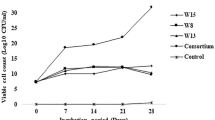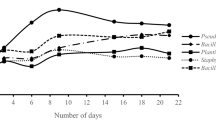Abstract
Bioremediation has been attracting researchers’ attention to develop as a technique to remove the pollution of crude oil in the environment. However, more or stronger novel strains capable of crude oil removal are still required. In this study, the potential of five newly isolated bacterial strains for crude oil abatement was evaluated in the liquid medium and contaminated soil individually and as a mixed consortium. Raoultella ornithinolytica strain PS exhibited the highest ability and degraded up to 83.5% of crude oil. Whereas Bacillus subtilis strain BJ11 degraded 81.1%, Acinetobacter lwoffii strain BJ10 degraded 75.8%, Acinetobacter pittii strain BJ6 degraded 74.9%, and Serratia marcescens strain PL degraded only 70.0% of crude oil in the liquid media. The consortium comprising the above five strains degraded more than 94.0% of crude oil after 10 days of incubation in the liquid medium. The consortium degraded more than 65.0% of crude oil after 40 days incubation even in the contaminated soil. The five crude oil degrading strains, especially their consortium, exhibited a high capability to break down a wide range of compounds in crude oil including straight-chain alkanes, branched alkanes, and aromatic hydrocarbons. These strains, especially as consortia, have good potential of application in the remediation of crude oil–contaminated environments.







Similar content being viewed by others
References
Leal, A. J., Rodrigues, E. M., Leal, P. L., Júlio, A. D. L., Fernandes, R. d. C. R., Borges, A. C., & Tótola, M. R. (2017). Changes in the microbial community during bioremediation of gasoline-contaminated soil. Brazilian Journal of Microbiology, 48(2), 342–351.
Tyagi, M., da Fonseca, M. M., & de Carvalho, C. C. (2011). Bioaugmentation and biostimulation strategies to improve the effectiveness of bioremediation processes. Biodegradation, 22(2), 231–241.
Suja, F., Rahim, F., Taha, M. R., Hambali, N., Razali, M. R., Khalid, A., & Hamzah, A. (2014). Effects of local microbial bioaugmentation and biostimulation on the bioremediation of total petroleum hydrocarbons (TPH) in crude oil contaminated soil based on laboratory and field observations. International Biodeterioration & Biodegradation, 90, 115–122.
Santisi, S., Cappello, S., Catalfamo, M., Mancini, G., Hassanshahian, M., Genovese, L., Giuliano, L., & Yakimov, M. M. (2015). Biodegradation of crude oil by individual bacterial strains and a mixed bacterial consortium. Brazilian Journal of Microbiology, 46(2), 377–387.
Dzionek, A., Wojcieszyńska, D., & Guzik, U. (2016). Natural carriers in bioremediation: a review. Electronic Journal of Biotechnology, 23, 28–36.
Bento, F. M., Camargo, F. A. O., Okeke, B. C., & Frankenberger, W. T. (2005). Comparative bioremediation of soils contaminated with diesel oil by natural attenuation, biostimulation and bioaugmentation. Bioresource Technology, 96(9), 1049–1055.
Wu, M., Dick, W. A., Li, W., Wang, X., Yang, Q., Wang, T., Xu, L., Zhang, M., & Chen, L. (2016). Bioaugmentation and biostimulation of hydrocarbon degradation and the microbial community in a petroleum-contaminated soil. International Biodeterioration & Biodegradation, 107, 158–164.
Al-Sayegh, A., Al-Wahaibi, Y., Joshi, S., Al-Bahry, S., Elshafie, A., & Al-Bemani, A. (2016). Bioremediation of heavy crude oil contamination. The Open Biotechnology Journal, 10(1), 301–311.
Li, X., Zhao, L., & Adam, M. (2016). Biodegradation of marine crude oil pollution using a salt-tolerant bacterial consortium isolated from Bohai Bay, China. Marine Pollution Bulletin, 105(1), 43–50.
Sathishkumar, M., Binupriya, A. R., Baik, S.-H., & Yun, S.-E. (2008). Biodegradation of crude oil by individual bacterial strains and a mixed bacterial consortium isolated from hydrocarbon contaminated areas. Clean: Soil, Air, Water, 36, 92–96.
Rahman, K. S., Thahira-Rahman, J., Lakshmanaperumalsamy, P., & Banat, I. M. (2002). Towards efficient crude oil degradation by a mixed bacterial consortium. Bioresource Technology, 85(3), 257–261.
Marchand, C., St-Arnaud, M., Hogland, W., Bell, T. H., & Hijri, M. (2017). Petroleum biodegradation capacity of bacteria and fungi isolated from petroleum-contaminated soil. International Biodeterioration & Biodegradation, 116, 48–57.
Sutton, N. B., Maphosa, F., Morillo, J. A., Abu Al-Soud, W., Langenhoff, A. A., Grotenhuis, T., Rijnaarts, H. H., & Smidt, H. (2013). Impact of long-term diesel contamination on soil microbial community structure. Applied and Environmental Microbiology, 79(2), 619–630.
Shetaia, Y. M., El Khalik, W. A., Mohamed, T. M., Farahat, L. A., & Elmekawy, A. (2016). Potential biodegradation of crude petroleum oil by newly isolated halotolerant microbial strains from polluted Red Sea area. Marine Pollution Bulletin, 111(1-2), 435–442.
Liu, B., Ju, M., Liu, J., Wu, W., & Li, X. (2016). Isolation, identification, and crude oil degradation characteristics of a high-temperature, hydrocarbon-degrading strain. Marine Pollution Bulletin, 106(1-2), 301–307.
Hassanshahian, M., Yakimov, M. M., Denaro, R., Genovese, M., & Cappello, S. (2014c). Using real-time PCR to assess changes in the crude oil degrading microbial community in contaminated seawater mesocosms. International Biodeterioration & Biodegradation, 93, 241–248.
Haluschak, P. (2006). Laboratory methods of soil analysis. Canada-Manitoba soil survey, 3–133.
Roy, A. S., Baruah, R., Borah, M., Singh, A. K., Deka Boruah, H. P., Saikia, N., Deka, M., Dutta, N., & Chandra Bora, T. (2014). Bioremediation potential of native hydrocarbon degrading bacterial strains in crude oil contaminated soil under microcosm study. International Biodeterioration & Biodegradation, 94, 79–89.
Hassanshahian, M. (2014). Isolation and characterization of biosurfactant producing bacteria from Persian Gulf (Bushehr provenance). Marine Pollution Bulletin, 86(1-2), 361–366.
Hassanshahian, M., Zeynalipour, M. S., & Musa, F. H. (2014). Isolation and characterization of crude oil degrading bacteria from the Persian Gulf (Khorramshahr provenance). Marine Pollution Bulletin, 82(1-2), 39–44.
Chikere, C. B., Chikere, B. O., & Okpokwasili, G. C. (2012). Bioreactor-based bioremediation of hydrocarbon-polluted Niger Delta marine sediment, Nigeria. 3 Biotech, 2(1), 53–66.
Obi, L. U., Atagana, H. I., & Adeleke, R. A. (2016). Isolation and characterisation of crude oil sludge degrading bacteria. SpringerPlus, 5, 1946.
Brenner, D. J., Krieg, N. R., & Staley, J. T. (2005). Bergey’s manual® of systematic bacteriology (2nd ed.). New York: Springer-Verlag.
Tamura, K., Nei, M., & Kumar, S. (2004). Prospects for inferring very large phylogenies by using the neighbor-joining method. Proceedings of the National Academy of Sciences of the United States of America, 101(30), 11030–11035.
Felsenstein, J. (1985). Confidence limits on phylogenies: an approach using the bootstrap. Evolution, 39(4), 783–791.
Kumar, S., Stecher, G., Li, M., Knyaz, C., & Tamura, K. (2018). MEGA X: molecular evolutionary genetics analysis across computing platforms. Molecular Biology and Evolution, 35(6), 1547–1549.
Sezonov, G., Joseleau-Petit, D., & D'Ari, R. (2007). Escherichia coli physiology in Luria-Bertani broth. Journal of Bacteriology, 189(23), 8746–8749.
Vidali, M. (2001). Bioremediation. An overview. Pure and Applied Chemistry, 73(7), 1163–1172.
Asadirad, M. H. A., Assadi, M. M., Rashedi, H., & Nejadsattari, T. (2016). Effects of indigenous microbial consortium in crude oil degradation: a microcosm experiment. International Journal of Environmental Research, 10, 491–498.
Yan, S., Wang, Q., Qu, L., & Li, C. (2013). Characterization of oil-degrading bacteria from oil-contaminated soil and activity of their enzymes. Biotechnology & Biotechnological Equipment, 27(4), 3932–3938.
Oyetibo, G. O., Chien, M.-F., Ikeda-Ohtsubo, W., Suzuki, H., Obayori, O. S., Adebusoye, S. A., Ilori, M. O., Amund, O. O., & Endo, G. (2017). Biodegradation of crude oil and phenanthrene by heavy metal resistant Bacillus subtilis isolated from a multi-polluted industrial wastewater creek. International Biodeterioration & Biodegradation, 120, 143–151.
Sakthipriya, N., Doble, M., & Sangwai, J. S. (2015). Bioremediation of coastal and marine pollution due to crude oil using a microorganism Bacillus subtilis. Procedia Engineering, 116, 213–220.
Alegbeleye, O. O., Opeolu, B. O., & Jackson, V. (2017). Bioremediation of polycyclic aromatic hydrocarbon (PAH) compounds: (acenaphthene and fluorene) in water using indigenous bacterial species isolated from the Diep and Plankenburg rivers, Western Cape, South Africa. Brazilian Journal of Microbiology, 48(2), 314–325.
Morales-Guzmán, G., Ferrera-Cerrato, R., Rivera-Cruz, M. d. C., Torres-Bustillos, L. G., Arteaga-Garibay, R. I., Mendoza-López, M. R., Esquivel-Cote, R., & Alarcón, A. (2017). Diesel degradation by emulsifying bacteria isolated from soils polluted with weathered petroleum hydrocarbons. Applied Soil Ecology, 121, 127–134.
Hassanshahian, M., Emtiazi, G., & Cappello, S. (2012). Isolation and characterization of crude-oil-degrading bacteria from the Persian Gulf and the Caspian Sea. Marine Pollution Bulletin, 64(1), 7–12.
Hamzah, A., Rabu, A., Azmy, R. F. H. R., & Yussoff, N. A. (2010). Isolation and characterization of bacteria degrading Sumandak and south Angsi oils. Sains Malaysiana, 39, 161–168.
Yuan, X., Zhang, X., Chen, X., Kong, D., Liu, X., & Shen, S. (2018). Synergistic degradation of crude oil by indigenous bacterial consortium and exogenous fungus Scedosporium boydii. Bioresource Technology, 264, 190–197.
Liang, J., Cheng, T., Huang, Y., & Liu, J. (2018). Petroleum degradation by Pseudomonas sp. ZS1 is impeded in the presence of antagonist Alcaligenes sp. CT10. AMB Express, 8, 88.
Zaida, N. Z., & Piakong, M. T. (2018). Effectiveness of single and microbial consortium of locally isolated beneficial microorganisms (LIBeM) in bioaugmentation of oil sludge contaminated soil at different concentration levels: a laboratory scale. Journal of Bioremediation & Biodegradation, 9, 430.
Xia, M., Fu, D., Chakraborty, R., Singh, R. P., & Terry, N. (2019). Enhanced crude oil depletion by constructed bacterial consortium comprising bioemulsifier producer and petroleum hydrocarbon degraders. Bioresource Technology, 282, 456–463.
Patowary, K., Patowary, R., Kalita, M. C., & Deka, S. (2016). Development of an efficient bacterial consortium for the potential remediation of hydrocarbons from contaminated sites. Frontiers in Microbiology, 7, 1092.
Zhao, D., Liu, C., Liu, L., Zhang, Y., Liu, Q., & Wu, W.-M. (2011). Selection of functional consortium for crude oil-contaminated soil remediation. International Biodeterioration & Biodegradation, 65(8), 1244–1248.
Ebadi, A., Khoshkholgh Sima, N. A., Olamaee, M., Hashemi, M., & Ghorbani Nasrabadi, R. (2017). Effective bioremediation of a petroleum-polluted saline soil by a surfactant-producing Pseudomonas aeruginosa consortium. Journal of Advanced Research, 8(6), 627–633.
Van Hamme, J. D., Singh, A., & Ward, O. P. (2003). Recent advances in petroleum microbiology. Microbiology and Molecular Biology Reviews, 67(4), 503–549.
Peixoto, R. S., Vermelho, A. B., & Rosado, A. S. (2011). Petroleum-degrading enzymes: bioremediation and new prospects. Enzyme Research, 2011, 7.
Acknowledgments
This research was supported by the College of Biotechnology and Bioengineering at the Zhejiang University of Technology.
Author information
Authors and Affiliations
Corresponding author
Ethics declarations
Conflict of Interest
The authors declare that they have no conflict of interest.
Ethical Approval
This article does not contain any studies with human participants or animals performed by any of the authors
Additional information
Publisher’s Note
Springer Nature remains neutral with regard to jurisdictional claims in published maps and institutional affiliations.
Electronic Supplementary Material
ESM 1
(PDF 723 kb)
Rights and permissions
About this article
Cite this article
Bidja Abena, M.T., Sodbaatar, N., Li, T. et al. Crude Oil Biodegradation by Newly Isolated Bacterial Strains and Their Consortium Under Soil Microcosm Experiment. Appl Biochem Biotechnol 189, 1223–1244 (2019). https://doi.org/10.1007/s12010-019-03058-2
Received:
Accepted:
Published:
Issue Date:
DOI: https://doi.org/10.1007/s12010-019-03058-2




